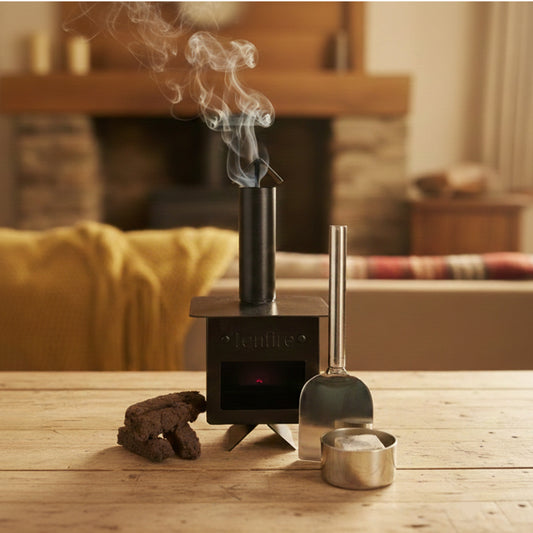
What Types Of Candles Are Bad For You?
By Dawn, Founder of Tenfire
Candles bring warmth, calm, and atmosphere—but not all candles are created equal. Some can fill your home with comfort, while others may quietly add smoke, toxins, or irritants to your space.
As the founder of Tenfire, I’m passionate about fragrance—but I’m even more focused on safety and quality. This guide breaks down the types of candles that may not be good for you, and what to look for instead.
If you want the glow without the risk, read on.
TL;DR – Are Candles Bad for You?
- Paraffin wax can release soot and VOCs
- Metal-core wicks (especially older ones) may contain lead
- Cheap synthetic fragrances can trigger reactions
- Poorly made candles can damage surfaces or air quality
- Safer choices: natural waxes, clean-burning wicks, tested containers
Why Candle Safety Matters
Lighting a candle feels natural—but it’s still a controlled burn happening inside your home. Everything from the wax, to the wick, to the container can impact how safe that experience is.
When candles are made with poor materials or little testing, they can:
- Emit pollutants or irritants
- Release black soot onto walls and ceilings
- Cause headaches or allergies
- Overheat and shatter
Good candles shouldn’t add risk—they should reduce stress.
1. Paraffin Wax Candles

Paraffin is a petroleum by-product—left over from the oil refining process. It’s cheap, widely available, and holds scent well. That’s why it’s still common in mass-market candles.
But burning paraffin releases:
- Soot (tiny black carbon particles)
- Volatile organic compounds (VOCs) like toluene and benzene
These compounds have been linked to:
- Respiratory irritation
- Headaches
- Aggravation of asthma or allergies
Better option: Candles made from soy, beeswax, or coconut wax. These natural waxes burn cleaner and slower.
2. Metal-Core Wick Candles
In older or very cheap candles, you might find a wick with a metal wire at its core. This helps the wick stand up while burning—but the materials can be dangerous.
What’s the concern?
- Lead wicks were once used, and when burned, can release harmful lead particles into the air
- Lead inhalation, even in small doses, is dangerous—especially for children
How to check:
- Look at the tip of the wick—if it has a metallic center, avoid it
- Stick to cotton or wooden wicks from reputable candle makers
3. Synthetic Fragrance Candles
Fragrance is one of the main reasons we love candles—but not all fragrance ingredients are created equally.
Some cheaper candles use synthetic fragrance oils that contain:
- Phthalates – may disrupt hormones or trigger sensitivities
- Unlisted irritants that can cause headaches, dizziness, or allergic reactions
Better choices:
- Clear labelling so you know what you're getting
- Phthalate-free fragrance oils
- Essential oil blends (though some may still trigger sensitivities)
4. Novelty or Mass-Market Candles
You’ve seen them—fun shapes, bright colours, off-brand packaging at a market or dollar store. These candles may look cute but often skip safety testing.
Common issues include:
- Dyes that stain tables or surfaces when melted
- Poor wick placement that causes tunnelling or overheating
- Low-quality containers that crack or overheat
- Fragrance overload that causes headaches
Rule of thumb: If the candle doesn’t list ingredients, skip it.
5. Poor-Tested Candle Containers
You can make the best wax and wick in the world—but if the container can’t handle heat, the whole candle becomes unsafe.
Problems with bad containers:
- Cracking under heat
- Leaking wax
- Tipping easily
- Conducting heat dangerously (especially thin glass)
Always choose candles in heat-tested jars, tins, or ceramics from brands that disclose container safety.
How to Choose Safer Candles
Here’s a simple checklist for safer, cleaner candles:
- ✅ Wax is natural: soy, beeswax, coconut, or a tested blend
- ✅ Wick is cotton or wood, with no metal core
- ✅ Fragrance is phthalate-free or transparently labeled
- ✅ No suspicious dyes or heavily perfumed formulas
- ✅ Maker confirms heat-tested containers
- ✅ Brand is open about their ingredients and testing process
What Tenfire Uses (and Why)

At Tenfire, we:
- Use 100% soy wax for slow, clean burning
- Choose cotton wicks, always lead-free
- Blend premium fragrances—many are phthalate-free, and all are tested for performance and skin sensitivity
- Pour into easily recycled tin plate tins and heat-tested vessels
- Test every scent for clean melt, flame height, and scent throw
A Note on Phthalates and Transparency
Phthalates get a lot of attention—and with good reason. Some people prefer to avoid them completely, especially if they have small children or sensitivities.
We believe in transparency. That’s why we:
- Clearly label phthalate-free scents
- Avoid unnecessary additives
- Share full ingredient lists on request
Safe Candle Use Tips
- Burn in well-ventilated areas
- Keep wicks trimmed to 5mm
- Don’t burn longer than 4 hours at a time
- Keep candles away from children and pets
- Let wax cool before trimming or moving
- Don’t leave candles unattended
Final Thoughts from Dawn
So—are candles bad for you? Not if they’re made with care, clean ingredients, and the right kind of testing.
The real issue isn’t candles themselves—it’s what they’re made of. When you choose quality materials, you get the beauty and calm of candlelight without worry.
At Tenfire, we obsess over these details. Because what goes into your candle matters as much as what comes out of it.
Here’s to clean burns and calm nights,
Dawn
Founder, Tenfire





